This post has not been edited by the GamesBeat staff. Opinions by GamesBeat community writers do not necessarily reflect those of the staff.

Welcome guys and gals to yet another review. Tonight, we are going to look at another entry from a series that helped re-invent the point and click adventure genre and no, it’s not another Professor Layton game (I can’t read Japanese nor do I have the money to import). This is a review of the latest entry in the Ace Attorney franchise (to leave Japan), which also happens to be one of my favorite games of 2010. I was going to review Apollo Justice first, since the last entry I reviewed was Trials and Tribulations but I figured it would be best to review the games I have in the order that they appear of the series time-line, rather than the order of release.
For those who are unfamiliar with the Ace Attorney series, it should be said that Miles Edgeworth is a prosecutor who served as the main rival (in the first game anyway) for the series main protagonist (for the first three games anyway), defense attorney Phoenix Wright, who ironically was an old friend from grade school. Edgeworth’s goal was to avenge his father’s murder by bringing all criminals to justice by the means of always getting the guilty verdict, no matter the cost. However, after his courtroom battles with Phoenix his attitude began to change and came to the conclusion that Prosecutors should be more focused on finding the truth, rather than just winning the trail, even if that means working with the defense.
Investigations is his first solo adventure under this new perspective but rather than taking place in the courtroom, he is fighting for the truth at the scene of the crime. Is Edgeworth an Ace Attorney worth Investigating?
It should be noted that these events take place sometime between those seen in Phoenix Wright Ace Attorney: Trials and Tribulations and when Apollo Justice fist entered a courtroom.
Like in every other Ace Attorney game, the plot of Investigations is stretched out over the span of a few episodes (five in this case). The first episode involves a murder in Edgeworth’s office after he returns from studying abroad. The second involves a murder during Edgeworth’s flight back into the country. The third involves a kidnapping/murder case at a police themed amusement park. The fourth is a flashback (seven years prior to these events) from what would have been his first trail had it not been for the murder of a prosecutor (I’m beginning to see a pattern here). Finally, the fifth involves a murder at an foreign embassy.
I told myself that I wasn’t going to use this joke but what the Hell:
[embed:http://www.youtube.com/watch?v=kdhhQhqi_AE ]
All of the events in these episodes are linked to an international smuggling ring that is said to have both the business world and court system in it’s back pocket and the return of a legendary thief known as the Yatagarasu, whose mission is to expose the connection between corporations and the ring by stealing incriminating documents and leaking them to the press.
In full honesty, I have to say that is a good story. The characters are as crazy and over the top as ever but they still manage to resonate well and are even deep and sympathetic characters at their core. Sure it has it’s moments where logic seems to leap out of the window but it’s all in good fun. Oh and don’t worry. Even amidst all of the drama, the wit and charm of the series is still intact. I also must say that I really enjoyed the way the game handled the time-line of the episodes. I find that it gives the player a unique perspective on the events that wouldn’t have been experienced if the flow was in the traditional sense of proper chronological order.
I guess I can’t talk about the story aspect without talking about the characters. Of course fan favorite’s like Detective Dick Gumshoe, who is still as whimsically/charmingly incompetent as ever and Franziska Von Karma, who is still her little blue bird of happiness self as he whips the piss out of everything in sight. There few more familiar characters from the series who play major roles and those who only make minor cameos but I don’t want to spoil who they are.
The two new main characters are Kay Faraday, a girl who claims to be the second Yatagarasu and for some reason decides to become Edgeworth’s new assistant (much to his chagrin). She seems to be just like any other overly energetic teenage girl character that seems to pop up a lot in anime inspired works and she does seem to go just a tad over board with the idea of being a thief but there is more to her than meets the eye. She is actually quite resourceful and becomes an incredibly valuable ally in Edgeworth’s search for truth and in return, he is a valuable ally in her noble agenda.
The second is an Interpol agent from the Republic of Zheng Fa by the name of Shi-Long Lang, who has the best arrest record in the entire agency. He has come to America (although this is clearly Japan) to track down the smuggling ring for its involvement in a counterfeit operation that has nearly destroyed Zheng Fa’s economy. He also has a genuine hatred for prosecutors and the court system. He is brutish, forceful, has a bad attitude and has a zero tolerance policy towards suspects. However, that’s not to say he doesn’t have a softer side, as he does treat all of his subordinates with the loyalty and respect they show him, if not better, as he sees them all as his extended family. In other words, he is the anti-Edgeworth, which makes him the perfect rival. Oh and his theme song kicks ass.
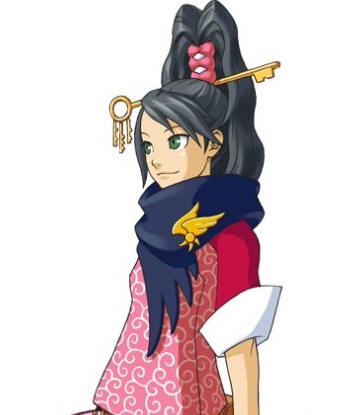
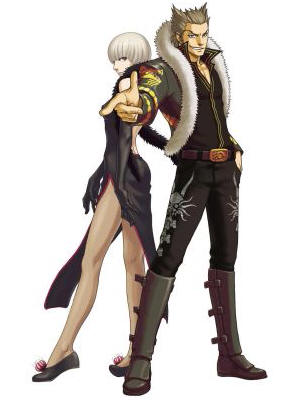
(New characters Kay Faraday (Left) and Shi-Long Lang and his assistant Shih-Na (right) )
How does Edgeworth fare in his first staring role? He does a great job actually. Sure his more snotty/pretentious attitude does make him a bit less likable than Pheonix. However, he is still a witty and likable character and the humor of the game even takes a few good shots at his expense when it comes to his less than likable qualities.
The game’s musical score is actually a rather unique melting pot of different styles. Some offerings have a heavy orchestra influence, some have an interesting jazz flavor, while others sound like something from a Sega Genesis cartridge, which is actually quite awesome. The music not only perfectly matches both the characters and the plot elements but they seem to naturally fit with Edgeworth’s personality to a tee. I guess that’s because of the sophisticated nature of the music matches the sophisticated (if not pretentious) nature of Edgey’s character.
AA: Investigations takes the series in a whole new direction in terms of graphical presentation. For the first time in series history, the investigation portions of the game are handled by 16-bit sprites while exploring a 16-bit background. I really must say that each character looks great (dare I say serving their still picture counterparts justice?) and are animated very well, although the same animations tend to get recycled, which is likely a Capcom money saving technique. The backgrounds are kind of bland in comparison to the character designs but while they may not be anything overly fantastic, serve their purpose well.
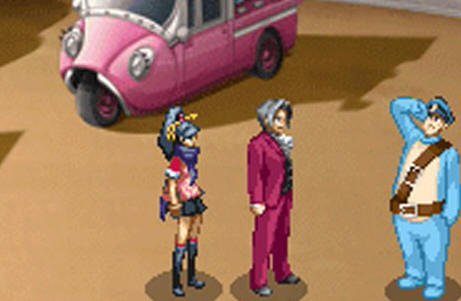
(I don't which is stupider? The costume or the man inside it?)
The series may be using character sprites for the first time but the sort of comic book style of using slightly animated pictures of the characters during the key dialogue scenes is still present and to be honest is still charming. It was nice to see that the characters received the Apollo Justice treatment in terms of getting a visual upgrade, as well as being slightly more animated than they were in the original trilogy. This is especially great for the epic emotional breakdowns performed by the perps after they are finally caught. It should also be noted that they are also part of another series first. Anywhere between two and four of these pictures can be on screen at a time and with the way these scenes are laid out, it actually looks like they are having a conversation, which is great and actually adds to the series’ sense of humor. Now we can finally see Edgeworth’s reaction to Gumshoe’s less than intellectual behavior. Of course close up photos of key crime scene elements/evidence are also used here like in past games and they work just as well here.
Gameplay wise, Edgeworth is pretty much the same as any other entry in the Ace Attorney franchise. You collect evidence and other bits of info from the crime scene and a few witnesses, which you place into your Court Record (Well this time it is an Organizer). You will then use the evidence/info from your Organizer to point out contradictions in each bit of testimony to defend the innocent and bring the real perpetrators to justice. Although, since these moments don’t take place in the courtroom this time around, they are referred to as Arguments and Rebuttals rather than Testimony and Cross-Examination. But remember, every time you try to connect the wrong piece of evidence to the wrong piece of testimony, you are going to take a hit on your “Truth Bar” (Ace Attorney ‘s version of the life bar). Once the Truth Bar is drained it is game over and the truth will be lost forever. But don’t worry. It is often easy to match the right piece of evidence to the correct piece of testimony and your Truth Bar will fill up again after every investigation and after each part of every episode. Even during particularly tricky Arguments, where your Truth Bar is in danger of running low, you have the safety net of being able to save at any point in the game that you want to, so even if loose the truth, you can find it again by continuing directly where you left off.
Exploring the crime scene is pretty much the same as in the other entries in the series, except you can now interact with the background as a sprite and locate a piece of evidence by walking up to it and pressing a button. Same thing goes for when you want to talk with another character. Walk up to them, press the button and Eureka! You have an instant conversation starter. Of course (like I said earlier) you also have those moments when you are looking at a piece of evidence up close. When this happens (just like in the other games) you use the cursor to zero in on what it is that makes it so suspicious.
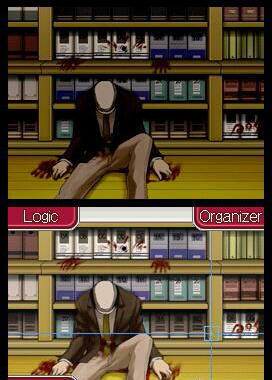
(Of course the murder would occur in my office! Sigh.This this just isn't my day)
But enough pointing out the gameplay similarities between the exploits of Wright and Edgeworth. Let’s talk about the differences. AA: Investigations is the first entry in the series to use the Partner mechanic. This is basically a substitute for being able to return to the office and ask for your assistant’s perspective on the case, since you can only explore one area at a time. During each investigation, you will be given a partner (Gumshoe, Kay or Franziska). This partner can give you a new perspective on the case and can even add some insight on pieces of evidence. This is a useful tool to have at your disposal and it can actually add some extra insight into the game’s plot, as well as to the banter between characters, which is always fun.
It is also the first in the series to feature Re-enactments. You see, Kay has a special little gadget, which allows her to re-create the events of each crime with the use of holographic imagery. All she needs is the information that was gathered through out the investigation and presto, the crime will be re-enacted by the miracle of modern technology. However, this is based merely on the info your currently have, so you will have to discover and correct the contradictions that exist in these re-enactments. This is a pretty cool feature and definitely adds a new sense of depth to each case.
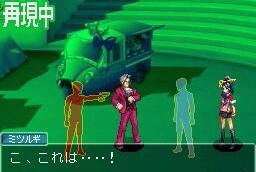
(What manner of sorcery is this?)
The last new feature is the Logic mechanic. Each Ace Attorney seems to have his own unique power. Phoenix Wright could see into people’s hearts with his Magatama. Apollo Justice had a magic bracelet that allowed him perceive when people were lying to him (kinda like a lamer Dare Devil). Well, Edgeworth has his own ability, which isn’t a super power because anyone can win with super powers because that’s cheating. His is the power of Logic that he acquired with all of his fancy pants upper class book learnins.
How does Logic work? Well if he notices something interesting about a piece of evidence, he’ll make a mental note of it. If a witness tells him something he didn’t already know about an aspect of the crime scene, he’ll make a mental note of it. The purpose of Logic is to connect pairs of these mental notes together to expand your understanding of the situation. Usually it is pretty obvious which mental notes are supposed to be paired together. For instance a typical example would look something like this: “Character Y was shot with a gun.” “The gun belongs to Character X.” “If some one catches me in the act, I’ll tell them I accidentally Tivo’d Steel Samurai so I figured that may as well watch it. Yes Miles. You are the master of deception :).” OK, so maybe I completely made up that last one but you get my point.
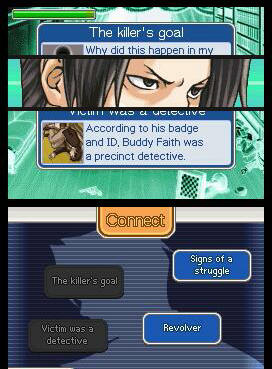
(Behold the power of Logic!)
So, it’s pretty obvious that you would link the first notes together to figure out that Y was likely shot by X and this new info about the gun is added to the Organizer. It should be said that although most of the mental notes are pretty easy to pair up, the Logic will get increasingly crazy (as per usual in the series), thus making the process harder but not too hard.
Miles Edgeworth: Ace Attorney Investigations may be a tad on the easy side, it’s logic may be lacking at times and it may be a tad too linear for some tastes but it has the series’ signature whit and charm and not to mention a few twists of its own to keep a good lasting appeal. Or at the very the least a single solid 15 hour play through. If you are a fan of the series, this is a must have. For any one who is interested in giving the series a chance this is a fine entry to start with.
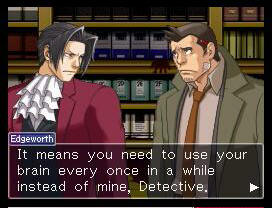
(I believe this is what the children call a burn)
Final Score: 8/10
